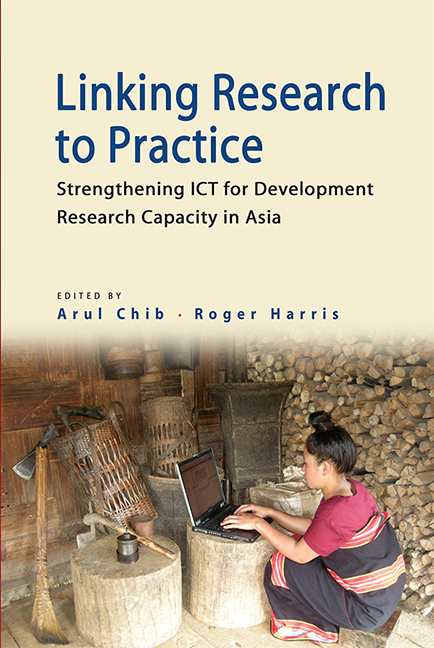Book contents
- Frontmatter
- Contents
- List of Tables
- List of Figures
- Foreword
- Preface
- Acknowledgement
- SECTION I MANAGEMENT PERSPECTIVES: INSIDERS' THOUGHTS ON THE PROGRAMME
- SECTION II RESEARCH PERSPECTIVES: THEORETICAL REFLECTIONS BY EXPERTS
- SECTION III RESEARCH OUTPUTS
- 11 It's the Talk, Not the Tech: What Governments Should Know about Blogging and Social Media
- 12 Integrating Digital and Human Data Sources for Environmental Planning and Climate Change Adaptation: From Research to Practice in Central Vietnam
- 13 The Challenge of Working Across Contexts and Domains: Mobile Health Education in Rural Cambodia
- 14 The Dynamics and Challenges of Academic Internet Use Amongst Cambodian University Students;
- SECTION IV SYNTHESIS AND CONCLUSION
- About the Contributors0
- Index
12 - Integrating Digital and Human Data Sources for Environmental Planning and Climate Change Adaptation: From Research to Practice in Central Vietnam
from SECTION III - RESEARCH OUTPUTS
Published online by Cambridge University Press: 21 October 2015
- Frontmatter
- Contents
- List of Tables
- List of Figures
- Foreword
- Preface
- Acknowledgement
- SECTION I MANAGEMENT PERSPECTIVES: INSIDERS' THOUGHTS ON THE PROGRAMME
- SECTION II RESEARCH PERSPECTIVES: THEORETICAL REFLECTIONS BY EXPERTS
- SECTION III RESEARCH OUTPUTS
- 11 It's the Talk, Not the Tech: What Governments Should Know about Blogging and Social Media
- 12 Integrating Digital and Human Data Sources for Environmental Planning and Climate Change Adaptation: From Research to Practice in Central Vietnam
- 13 The Challenge of Working Across Contexts and Domains: Mobile Health Education in Rural Cambodia
- 14 The Dynamics and Challenges of Academic Internet Use Amongst Cambodian University Students;
- SECTION IV SYNTHESIS AND CONCLUSION
- About the Contributors0
- Index
Summary
ABSTRACT
Climate-related and climate change-related events are causing problems for agricultural communities in many developing countries, and are requiring new practices that enable these communities to adapt. In planning adaptation practices, two quite different data sources have been common — top-down digital sources such as those provided by remote sensing, and bottom-up human sources such as those provided by participatory events. These can be brought together via geographic information systems to produce a more robust guide for adaptational decision-making. This paper reports one such initiative in Central Vietnam which integrated local and external data sources — geographical, economic, political, and agricultural — in order to provide guidance on environmental planning. The paper reports on the transfer from research modelling to environmental practice, and also draws some broader conclusions about data source integration for ICT4D practitioners including the need to re-engineer planning processes rather than simply automate traditional — often narrowly-scientific and top-down — approaches.
ICTs AND CLIMATE CHANGE ADAPTATION STRATEGIES
Although there is still ongoing debate, there seems to be a general consensus that climate change is a reality, and a reality that is causing particular problems for farmers in developing countries (Ospina and Heeks 2010a). There are problems such as the melting of glaciers, flooding, and spread of desertification or of new vector-borne diseases due to changes in temperature (IPCC 2007). In this paper, we will focus on two problems specific to highland farming: landslides and soil erosion.
Of course, these have occurred throughout the history of agriculture, with landslides destroying life, livestock and property as well as agricultural land, and with erosion of two types — soil run-off from gullies and loss of land from river-sides — both impacting availability of good quality agricultural land (Chung et al. 1995; Morgan 2005). However, there is mounting evidence that both landslides and erosion are increasing and will further increase as a result of climate change, particularly due to changes in precipitation patterns (IPCC 2001; Ray and Joshi 2008).
Information
- Type
- Chapter
- Information
- Linking Research to PracticeStrengthening ICT for Development Research Capacity in Asia, pp. 132 - 146Publisher: ISEAS–Yusof Ishak InstitutePrint publication year: 2012
